Texas Lilac Vitex*
The Next Mega-Superstar Plant for Texas
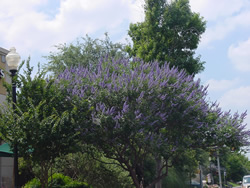
click
on any photo to download a large image suitable for media
purposes. |
| |
|
|
|
|
|
|
|
|
|
The uniqueness of the Texas Superstar plant program is that Texas
A&M
horticulturists discover and develop the unique characteristics
of otherwise well-known plants and make them even more desirable
and marketable to the gardening public.
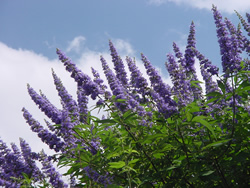 This
happened in 1989 with the introduction of Texas Bluebonnet transplants.
In 1990, Firebush (Hamelia patens) was introduced, followed by
the Surefire tomato in 1992, Satsumas (Mandarin oranges) and the
'Texas Gold' columbine in 1993, the 'Merced' tomato in 1997, 'Blue
Princess' verbena in 1998, the 'Gold Star Esperanza' in 1999,
the 'VIP' and 'Laura Bush' petunias in 1999 and 2001 respectively,
the 'Moy Grande' and 'Flare' perennial hibiscus in 2000, 'Belinda's
Dream' rose in 2002 and 'Tomato 444' in 2004. This
happened in 1989 with the introduction of Texas Bluebonnet transplants.
In 1990, Firebush (Hamelia patens) was introduced, followed by
the Surefire tomato in 1992, Satsumas (Mandarin oranges) and the
'Texas Gold' columbine in 1993, the 'Merced' tomato in 1997, 'Blue
Princess' verbena in 1998, the 'Gold Star Esperanza' in 1999,
the 'VIP' and 'Laura Bush' petunias in 1999 and 2001 respectively,
the 'Moy Grande' and 'Flare' perennial hibiscus in 2000, 'Belinda's
Dream' rose in 2002 and 'Tomato 444' in 2004.
The Texas SuperStar* plant for the summer of 2005 will surely
join this elite group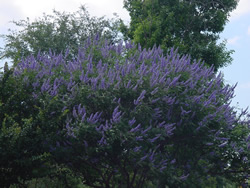 of SuperStar "old-plants-revisited-and-revitalized"
category to become a million-dollar seller. It is the Texas Lilac
Vitex*, or Chaste tree (Vitex agnus-castus).
of SuperStar "old-plants-revisited-and-revitalized"
category to become a million-dollar seller. It is the Texas Lilac
Vitex*, or Chaste tree (Vitex agnus-castus).
This tree is also known as Mexican lavender, monk's pepper,
lilac chaste tree, hemp tree, sage tree, or Indian spice. It is
a native of China and India, although long ago it became naturalized
throughout certain areas of the United Stated. Records indicate
that Vitex has been cultivated in the U.S. since 1670.
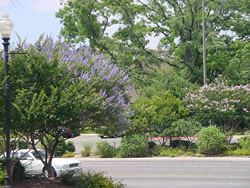 For
people living in the warmer parts of the South, the lilac chaste
tree has been the shrub or small-flowering tree of choice to mimic
the much beloved lilacs that are restricted to cooler regions.
It grows best when planted in full sun and in a location that
drains well. It will grow well in all areas of Texas, in both
acid and alkaline soils. It prospers in hot and dry environments.
The Texas Department of Transportation recognizes its toughness,
and plants Vitex in highway medians. It is a spectacular butterfly-attracting
plant and is deer resistant in that deer will not eat it, although
they can damage it with their antlers if it is allowed to grow
very large. For
people living in the warmer parts of the South, the lilac chaste
tree has been the shrub or small-flowering tree of choice to mimic
the much beloved lilacs that are restricted to cooler regions.
It grows best when planted in full sun and in a location that
drains well. It will grow well in all areas of Texas, in both
acid and alkaline soils. It prospers in hot and dry environments.
The Texas Department of Transportation recognizes its toughness,
and plants Vitex in highway medians. It is a spectacular butterfly-attracting
plant and is deer resistant in that deer will not eat it, although
they can damage it with their antlers if it is allowed to grow
very large.
So, if all of this "good stuff" is known about Vitex,
why isn't it more popular than it 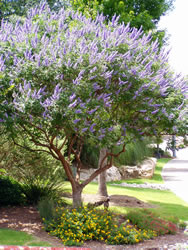 is?
This is where the work of the SuperStar horticulturists begins.
The older selections of Vitex had small spikes of flowers which
were pale lilac, mauve, off-white or light pink. The blooms were
small and, for the most part, unattractive. Horticulturists now
have identified and tested improved varieties such as 'Montrose
Purple', 'LeCompte' and 'Shoal Creek' which have spikes as long
as 8 to 12 inches. All of these will be marketed under the name
of Texas Lilac Vitex*. is?
This is where the work of the SuperStar horticulturists begins.
The older selections of Vitex had small spikes of flowers which
were pale lilac, mauve, off-white or light pink. The blooms were
small and, for the most part, unattractive. Horticulturists now
have identified and tested improved varieties such as 'Montrose
Purple', 'LeCompte' and 'Shoal Creek' which have spikes as long
as 8 to 12 inches. All of these will be marketed under the name
of Texas Lilac Vitex*.
The bloom spikes on these improved varieties are not only large
and beautiful, they also are fragrant and provide long-lasting
cut flowers. However, after the bloom spikes have provided several
weeks of spectacular beauty, many aromatic black or dark-brown
seeds are produced. Not only do these seeds prevent a profusion
of additional bloom spikes, they may, in some regions of the state,
produce a seedling population that will not have the same characteristics
as the original plant and become a nuisance.
The obvious answer to this problem of seed production and resulting
reduction of blooms is to promptly cut off or deadhead the spent
bloom spikes after the first flowering so that the shrub will
bloom again. So, if the answer is so simple, why haven't people
been doing it for the last 100 years? The problem is how rapidly
the Vitex grows.
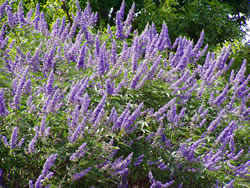 Vitex
reaches heights of 25 feet in good soils, but most specimens in
the San Antonio area are about 12 to 15 feet tall. It is a tree
that is inclined to be about twice as wide as it is tall, so folks
have the tendency to allow the plant to become overgrown and consequently,
seed pods cannot be easily reached and removed. Peach growers
prune their trees for the same reason that you will need to "prune"
Vitex - so that they can reach the peaches during harvest, just
as you will want to reach the seed pods when its time to remove
them. Vitex
reaches heights of 25 feet in good soils, but most specimens in
the San Antonio area are about 12 to 15 feet tall. It is a tree
that is inclined to be about twice as wide as it is tall, so folks
have the tendency to allow the plant to become overgrown and consequently,
seed pods cannot be easily reached and removed. Peach growers
prune their trees for the same reason that you will need to "prune"
Vitex - so that they can reach the peaches during harvest, just
as you will want to reach the seed pods when its time to remove
them.
However, to some people, cutting is like killing. If you have
that attitude, you will not enjoy the maximum floral display of
the Texas Lilac Vitex* - only the spring bloom. The Texas Lilac
Vitex* must be cut after EVERY bloom cycle, and cut back to the
ground EVERY winter. If you live in an area with a large deer
population, the deer rubbing their antlers on the Vitex will "prune"
the plant to the ground for you, or at least remind you to cut
the ravaged stems back. 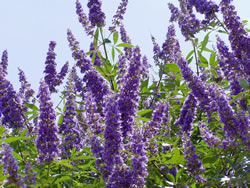
Remember, shrubs that bloom after June usually do so from buds
that are formed on shoots that grow the same year. These shrubs
should be pruned in late winter to promote vigorous shoot-growth
in spring. Examples of shrubs like Vitex that bloom on current
season's growth include: Buddleja davidii or B. globosa (buddleia
or butterfly bush), Hibiscus syriacus (shrub althea), Hypericum
spp. (St. Johnswort), Lagerstroemia indica (crape myrtle), and
Rosa spp. (roses). Most of us know to prune roses twice yearly
(early spring and fall), some of us realize that crape myrtle
seed pods should be removed to simulate repeat blooming, and now
we know that in order to make the Texas Lilac Vitex* produce an
abundance of beautiful cut flowers that furnish a constant source
of butterfly flower nectar, this plant MUST be cut often and severely.
Depending on weather and cultural conditions (fertilizer, water,
region of the state, etc.), plants will bloom again within six
weeks of seed pod/stalk removal. It is best to remove the seed
pods before they harden-the sooner after the bloom petals drop,
the better, and the faster the plant will come back into bloom.
To annually maintain the plant in a desirable size range of six
feet, plants should be cut within a few inches of the ground every
winter. It will sprout and bloom by June if cut to the ground
in winter. If the plant has gotten large during the previous growing
season, you can use a small chain saw to cut them back, then use
hedge shears to deadhead them during the growing season. Cutting
the plants back will make the spikes much longer but, of course,
there will be fewer of them (at least with the initial cut-down)-very
similar to the thinning of fruit crops to produce larger, high-quality
fruit. To stimulate rapid re-blooming and larger flower spikes,
three pounds of a slow-release formulation of lawn fertilizer
per 100 square feet should be scattered around each plant after
spent blooms have been removed. Make sure the lawn fertilizer
does NOT contain an herbicide.
Because of the growing conditions in much of Texas, many perennials
are best used as annuals, and many shrubs or small trees are best
used as perennials. This has been the case with the three very
successful Texas SuperStars* - firebush, esperanza and perennial
hibiscus. In most areas of Texas, firebush and perennial hibiscus
die to the ground every winter. Esperanza-and now Texas Lilac
Vitex* - should be cut to the ground every winter to keep the
plant manageable from season-to-season.
The butterfly craze has created a new interest in growing the
ultimate nectar plant known as buddleia or butterfly bush. Unfortunately,
the majority of buddleia do not perform well in most areas of
Texas and are not reliable perennials. However, the Texas Lilac
Vitex* can become the "buddleia" of Texas if handled
properly.
For those of you who want a medicinal plant for a SuperStar,
Vitex fills the bill. Vitex agnus-castus belonged to the official
medicinal plants of antiquity and is mentioned in the works of
Hippocrates, Dioscorides and Theophrast.
The first specific medicinal indications of Vitex can be found
in the writings of Hippocrates, 4th Century B.C. He recommends
the plant for injuries, inflammation and swelling of the spleen.
He also suggests using the leaves in wine for hemorrhages and
the "passing of afterbirth". In his "Corpus Hippocratum",
Hippocrates writes, "If blood flows from the womb, let the
woman drink dark red wine in which the leaves of the chaste tree
have been steeped. A draft of chaste leaves in wine also serves
to expel a chorion held fast in the womb".
Dioscorides attributed to the fruit a hot and astringent activity,
and recommended it for wild animal bites, swelling of the spleen
and for dropsy. Decoctions of the fruit and plant were used as
sitz baths for diseases of the uterus. The English name for Vitex
agnus-castus, "chaste tree", is derived from the belief
that the plant would suppress libido in women. In Greek cities,
festivals in the honor of Demeter included a vow of chastity by
the local women. In Europe, the Catholic Church developed a variation
on this theme by placing the blossoms of the plant at the clothing
of novice monks to supposedly suppress their libido. The common
name "Monk's Pepper" refers to the medieval belief that
utilizing potions made from the berries helped monks maintain
their vows of chastity. There is nothing in contemporary scientific
literature to suggest that it actually does suppress the libido.
Early American physicians used it to stimulate lactation and as
an emmenagogic. It does, however, have an excellent track record
in relieving complaints collectively referred to as premenstrual
syndrome.
So, whether you want to stimulate the presence of butterflies
in your backyard with a drought-tolerant, pest-resistant plant,
or whether you want to try some ancient herbal remedies, the new
Texas Lilac Vitex* is the plant for you.
|



